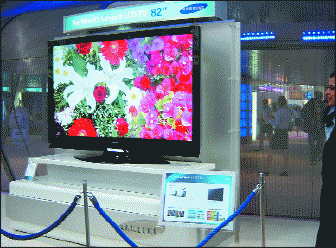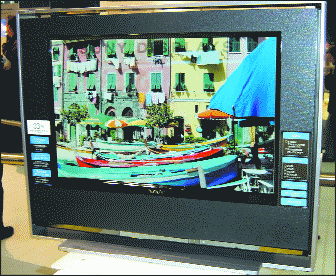A Quick Tour through CeBIT 2005
For the first time, Asian companies dominated the monitor hall, occupying space previously held by European companies not attending this year's show.
by Michelle Barnes and Bryan Norris
CeBIT 2005, held in Hannover, Germany, March 10–16, attracted 6270 exhibitors and 480,000 visitors. The show now provides an important showcase for Asian companies who desire to present their products to the European market, and 1677 of the 6270 exhibitors were from the Asian– Pacific region. The monitor hall was dominated by two of the largest Asian suppliers, LG and Samsung. These two Korean behemoths of the display industry had huge stands incorporating space that in previous years had been occupied by European companies, some of whom decided not to attend the show this year.
Like their stands, the monitor products from LG and Samsung continue to increase in size. Samsung unveiled two new giant units, a 102-in. plasma display featuring 1920 x 1080 progressive-scan TV and 68.7 billion displayable colors and the "world's largest" 82-in. LCD TV, the 82F5, which can also function as a computer display thanks to a built-in HDMI port (Fig. 1). The 82F5 boasts an 8-msec response time, a luminance of 500 cd/m2, and the "industry's highest dynamic contrast ratio of 10,000:1."
LG launched the "world's first 71-in. PDP" – a Luxury Gold Design model decorated with 24-karat gold and packaged with a home-theater system and set-top box. It was being marketed in Korea as "the world's most expensive PDP" at 80 million won (slightly over $US80,000), and there were plans to launch the model in North America, the Middle East, and the CIS region (the Commonwealth of Independent States, the organization of states of the former Soviet Union).
LG was also promoting its forthcoming 55-in. WUXGA LCD-based information display, the M5500C, which features an 8-msec response time and a 178° viewing angle. And for the rapidly expanding public-information-display (PID) market, LG exhibited its FLATRON Wide Display series of LCDs, which includes the company's first 46-, 37-, and 32-in. models.
 Bryan Norris
Bryan Norris
Fig. 1: Samsung showed its model 82F5 LCD TV. With a screen diagonal of 82 in., it is the world's largest, and it can also function as a computer display thanks to a built-in HDMI port.
The Japanese contingent was also keen to present new impressively large products. NEC–Mitsubishi was showing its first 46-in. PID, the NEC LCD4610. The company also unveiled a new 40-in., the LCD4010, and a demonstration 32-in., the LCD3210. Sony was promoting its first LCD-based information displays with its 42-in. FWD-42LX1 and 32-in. FWD-32LX1. These are primarily designed for public-information environments, but also feature DVI-HDCP inputs capable of accepting HDTV signals. And Panasonic had its first information LCD, the 32-in. TH-32LHD7. Sony and Panasonic have been prominent in PDP-based PIDs, so their climbing on board the LCD bandwagon is intriguing.
OLED Screens and LED Backlights
CeBIT is, of course, an ideal venue for companies to unveil their newest advances in display technology, and this year's show was no exception. LG unveiled a new active-matrix OLED display, based on a low-temperature-polysilicon (LTPS) backplane. At 20.1 in., LG was claiming it to be the world's largest LTPS OLED display. The wide-XGA unit has a contrast ratio of 1000:1 and luminance of 500 cd/m2, and it can display 16.7 million colors.
A number of LCD monitors with LED backlights were being demonstrated by various exhibitors, showing that real advances have been made in this technology over the last couple of years. LG showed its prototype LED-backlit 42-in. TV monitor for commercial applications, the L4200A FLATRON Ad. A list of the benefits of the LED backlight included dimmability for brightness control, excellent RGB color gamut, tunable color temperature, low-voltage operation, absence of mercury, and no UV/IR emissions.
Samsung was showing a 40-in. LED-backlit unit featuring a color gamut of 105% NTSC, a luminance of 300 cd/m2, a contrast ratio of 1000:1, a viewing angle of 178°, and a pixel format of 1920 x 1200. This unit was placed next to a conventional CCFL-backlit monitor and an FFL-backlit monitor, and all three models were showing real-time video images of brightly colored lava lamps placed in a set-up alongside (Fig. 2). Compared to the CCFL and FFL units, the LED-backlit model presented the colors of the lamps in a much truer and more vibrant depth.
 Bryan Norris
Bryan Norris
Fig. 2: Samsung also compared a 40-in. LED-backlit TFT-LCD having an NTSC color-gamut ratio of 105% to similar TFT-LCDs with CCFL and FFL backlights – all showing real-time video of colored lava lamps that was used for comparison. The color gamut and saturation of the LED-backlit panel was impressive.
 Bryan Norris
Bryan Norris
Fig. 3: The general excitement surrounding LED-backlit units was evident from the collection of LCDs in the 20-in. range that incorporated them. Among these were Sony's 23-in. LED-backlit unit from Japan, which it plans to release in the autumn of 2005.
NEC exhibited its "practically production-ready" LED-backlit 21.3-in. model, the SpectraView Ref 21, which is expected to be available in 2005 as part of NEC's new SpectraView range for the color-management market. Sony showed a 23-in. LED-backlit unit from Japan, which it aims to release in the autumn of 2005 (Fig. 3). And BenQ showed an LED-backlit prototype of its 23-in. FP231W.
Niche Products
Color performance is a key selling point for professionals who require color-calibration capabilities. Eizo's 22.2-in. CG220 and its new 21.3-in. CG210 incorporate a powerful new Eizo-developed ASIC, which has 14-bit-color-processing capability for gray-scale rendering that is on a par with high-end CRT monitors (Fig. 4). It provides much more color detail, especially in dark areas of the image. In addition, the CG220 is capable of displaying the Adobe RGB color space, which includes the ISO-coated and U.S. web-coated CMYK color spaces used in printing. iiyama presented its new GraphicPro LCD series, which gives users the benefit of 10-bit gamma correction, six-axis color control (cyan, magenta, and yellow, in addition to RGB), and an optional calibration tool called ii-style color. NEC's new SpectraView TFT monitors for the color-management market also have six-axis color control as well as a programmable 10-bit-gamma-correction function. Their color range covers most of the printablecolor space.
These three suppliers also have product ranges designed specifically for the medical-display market, where products must meet stringent imaging requirements and conform to standards such as DICOM (Digital Imaging and Communications in Medicine), which is internationally recognized. Such certifications are designed to ensure that medical staff in different locations all see identical representations of the same medical-examination results. Other suppliers with medical products were A.C.T. Kern, which has a wide range of medical-compliant monitors, Elo Touch-Systems, and SeeReal Technologies, with its 3-D displays.
For the financial and trading-room market, Eizo added a new 20-in. FlexScan model to its existing 19-in. offerings. The new monitor features a portrait-display function called ActiveRotation and an ActiveShot function that produces a picture-in-picture display from two computer sources so that traders can input data while watching stock-price movements.
The NEC MultiSync LCD1980FXi was shown off in a tiled bank of six units and boasted "the narrowest frame on the market" at only 12 mm. A wall of up to 25 units can be formed. LG tiled eight of its new 19-in. L1950S monitors in its "Narrow Bezel Zone." Samsung's SyncMaster 940Pn for dealing-room solutions features a mode switching time of less than 0.8 sec and dynamic priority switching on signals.
The Fastest Monitor
As is true of the gamers who use them, there is fierce competition among the display players who sell "gaming monitors."Samsung's 913N sub-8-msec monitor was being exhibited as "the fastest in the world," and the company also had a MagicSpeed2 demonstration on its stand, comparing a monitor with a 4-msec response time to one with a conventional 25-msec response time.BenQ exhibited the 17-in. FP71V+, "the first 5-msec gray-to-gray fast-response-time LCD monitor on the market." The 6-msec 19-in. FP91V+ was also on the stand, as was a 23-in. 3-D prototype for gaming.
Hyundai ImageQuest had a "High Speed Corner 8 msec" section at the front of its stand for gamers to try out its 8-msec L Series mon-itors. And NEC's 8-msec contender, the Multi-Sync LCD1970GX, had a high-gloss screen surface for enhanced color definition.LG introduced its first 8-msec monitors at CeBIT, the FLATRON 80 Ultra Slim series, which were presented as ideal for "die-hard gamers."
 Bryan Norris
Bryan Norris
Fig. 4: Eizo's 22.2-in. CG220 and new 21.3-in. CG210 LCDs incorporate a powerful new Eizo-developed ASIC that has 14-bit-color-processing capability (16 times more accurate than 10-bit color), providing gray-scale rendering on a par with high-performance CRT monitors and a much greater degree of color detail, especially in dark areas.
For parents worried about their childrens' gaming habits, BenQ showed its new "family-friendly" monitor, the FP72V. This monitor is designed to appeal to children with its "robotic" case and silver metallic color and also to adults with its timer for restricting the use of the computer.
Standing Out from the Crowd
Display designers have been very busy in the past year coming up with unique ideas to appeal to particular audiences. For the health-conscious, Samsung previewed its anion-emitting monitor, the 721SA MagicGreen, a display that emits 50,000 anions/cc within 30 cm to encourage "healthy blood and an active metabolism." The company also demonstrated a monitor for those with color-vision abnormalities – about 8% of males and 1–2% of females. The 930C comes with Samsung's MagicVision software, which customizes color correction according to how the user sees the color spectrum.
For users who like gadgetry, BenQ was exhibiting a Crazy Arm monitor, with five gadgets – a mirror, lamp, fan, webcam, and card reader – attached to the back on octopus-like arms. Pursuing the same theme, AG Neovo presented new consumer multimedia monitors that have a USB 2.0 port on the bezel to accommodate gadgets such as a fan and a light.
For style-conscious buyers, BenQ was showing its new silver and dark red FP785. Because of its folding base and handle, the unit has been carried like a handbag at the "Just Cavalli" fashion show during Milan fashion week. And for more arty types, LG introduced its new FLATRON Artistic 40 series with arched back and "art-deco-looking design," available in 17-, 19-, 20-, and 23-in. models [Figs. 5(a) and 5(b)].
The next CeBIT Hannover show is scheduled for March 9–15, 2006. •

 Bryan Norris
Bryan Norris
Fig. 5: LG's new high-style FLATRON Artistic 40 series have an arched back and an "art-deco-looking design."
Bryan Norris and Michelle Barnes are partners and co-founders of Bryan Norris Associates, Consultants to the Displays Industry, Bedford, U.K; telephone +44-(0)-1234-26-7988, fax +44-(0)-1234-26-2345, e-mail: info@bna-europe.com. Mr. Norris is a contributing editor to Information Display.